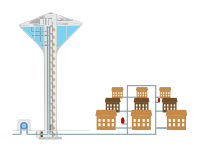
Photo from wikipedia
Drinking water distribution system contamination incidents can prompt public agencies and drinking water utilities to issue do-not-drink and do-not-use advisories. After the contaminant is cleared from distribution mains, consumers are… Click to show full abstract
Drinking water distribution system contamination incidents can prompt public agencies and drinking water utilities to issue do-not-drink and do-not-use advisories. After the contaminant is cleared from distribution mains, consumers are often directed to flush their plumbing. However, little validated guidance and few evaluated communications strategies are available on using flushing to decontaminate building water systems. Additionally, limited data support the effectiveness of current practices and recommendations. In this study, expert elicitation was used to assess existing flushing guidance and develop validated flushing guidance and communications for single-family residences. The resulting guidance recommends progressively opening all cold-water taps from the closest to point of entry to the furthest and allowing the water to run for at least 20 minutes. Hot-water taps should be opened progressively and run for at least 75 minutes. The guidance language and format conformed to grade-level and readability scores within recommended health communication ranges. The readability of eight other flushing guidance documents was also evaluated for contamination incidents from 2008-2015. Seven were written at a 10th-12th grade level, above the 6th-7th grade level recommended for health communications.
Journal Title: Journal of water and health
Year Published: 2019
Link to full text (if available)
Share on Social Media: Sign Up to like & get
recommendations!